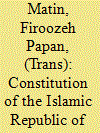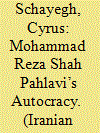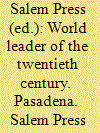|
|
|
Sort Order |
|
|
|
Items / Page
|
|
|
|
|
|
|
| Srl | Item |
| 1 |
ID:
127786


|
|
|
|
|
| Publication |
2014.
|
| Summary/Abstract |
On 3 December 1979, almost one year after Mohammad Reza Shah Pahlavi left Iran, the Constitution of the Islamic Republic of Iran replaced the monarchical constitution of 1906. The new constitution was to guarantee that the monarchy was abolished and the Islamic Republic system of government was enforced in its place. The constitution was to observe the Islamic and the nationalistic aims of the revolution with regard to the demands of a public that came from various social, religious, ethnic, and political backgrounds. Thus the 1979 constitution included differing components, which necessitated the amendments and the modifications that were added to the constitution in 1989. The constitution and its development are subjects that have been discussed in detail by scholars of modern Iran, among whom Asghar Schirazi stands out for his comprehensive study of the constitution. The following translation of the Constitution of the Islamic Republic of Iran highlights the relationship between the 1979 text of the constitution and the 1989 amendments in an attempt to contribute to the ongoing discussions on this subject.
|
|
|
|
|
|
|
|
|
|
|
|
|
|
|
|
| 2 |
ID:
177801


|
|
|
|
|
| Summary/Abstract |
Addressing the scarcity of scholarly literature on Iran’s involvement in Sub-Saharan Africa during the Pahlavi period, this paper demonstrates that throughout the 1970s, as the shah’s international standing rose and Iran’s economy grew, so too did Iran’s political and economic relationships with several African countries, especially Senegal. The article will explore a number of factors that stimulated this relationship, most significantly Senegal’s strategic and symbolic importance, and the personal friendships that developed between the countries’ leaders. The ultimate manifestation of this bilateral relationship was the Keur Farah Pahlavi project; a joint Iranian–Senegalese city to be constructed in Senegal. By exploring this project, the paper aims to demonstrate the strategies through which the Pahlavi state sought to expand its influence worldwide.
|
|
|
|
|
|
|
|
|
|
|
|
|
|
|
|
| 3 |
ID:
162784


|
|
|
|
|
| Summary/Abstract |
Even when Mohammad Reza Shah became an autocrat by the early 1960s, systemic constraints on his power persisted. One was government officials. They certainly accepted the shah’s governmental centrality. But in parallel they inventively created more elbowroom for themselves than they are normally credited for, shaping everyday administration and co-shaping policies. The article substantiates this argument in two steps. First, it looks at Iran’s Sāzmān-e bimeh-hā-ye ejtemāʿi-ye kārgarān (Workers Social Insurance Organization [SBIK]), drawing principally on French-language International Labor Organization (ILO) archival files. Although the shah had a well-publicized stake in social insurance expansion, the SBIK influenced policy strategy, sometimes against his explicit wishes; also, it handled routine operations and relations with the ILO independently from him. Second, the article zooms out to analyze Persian-language Harvard University Iranian Oral History Project interviews with high-ranking officials, alongside other published and unpublished sources, to show how government officials maintained some autonomy vis-à-vis the shah. Their strategies included self-effacement, the agreement on a unified cabinet policy position before a royal audience, resignation threats, open pushback, and gifts, including favors, to third parties.
|
|
|
|
|
|
|
|
|
|
|
|
|
|
|
|
| 4 |
ID:
165771


|
|
|
|
|
| Summary/Abstract |
This paper examines the Pahlavi National Library, the planning for which began in 1972 and expired in 1978 on the eve of the Islamic Revolution. The Pahlavi National Library was to rank in size and eminence with the great libraries of the world, yet this extraordinary project has hitherto received little to no scholarly attention. Using documents primarily from the archives of the shah’s cultural counsellor at the imperial court, Shojāʿeddin Shafā, this paper looks in detail at a number of initiatives spearheaded by Shafā from the early 1960s, which essentially laid the groundwork for the Pahlavi National Library, in order to understand how the shah’s regime used culture and scholarship to further its political goals. The paper proceeds to investigate the Pahlavi National Library, analyzing it in the context of the shah’s domestic and foreign policy objectives.
|
|
|
|
|
|
|
|
|
|
|
|
|
|
|
|
| 5 |
ID:
047125


|
|
|
|
|
| Publication |
Pasadena, Salem Press INC, 2000.
|
| Description |
2v. (xx, 419-838p.)Hbk
|
| Series |
Magill's Choice
|
| Contents |
Vol. II.: William Lyon Mackenzie King-Boris Yeltsin
|
| Standard Number |
0893563374
|
|
|
|
|
|
|
|
|
|
|
|
Copies: C:1/I:0,R:0,Q:0
Circulation
| Accession# | Call# | Current Location | Status | Policy | Location |
| 044333 | 920/SAL 044333 | Main | On Shelf | General | |
|
|
|
|
|
|
|
|
|